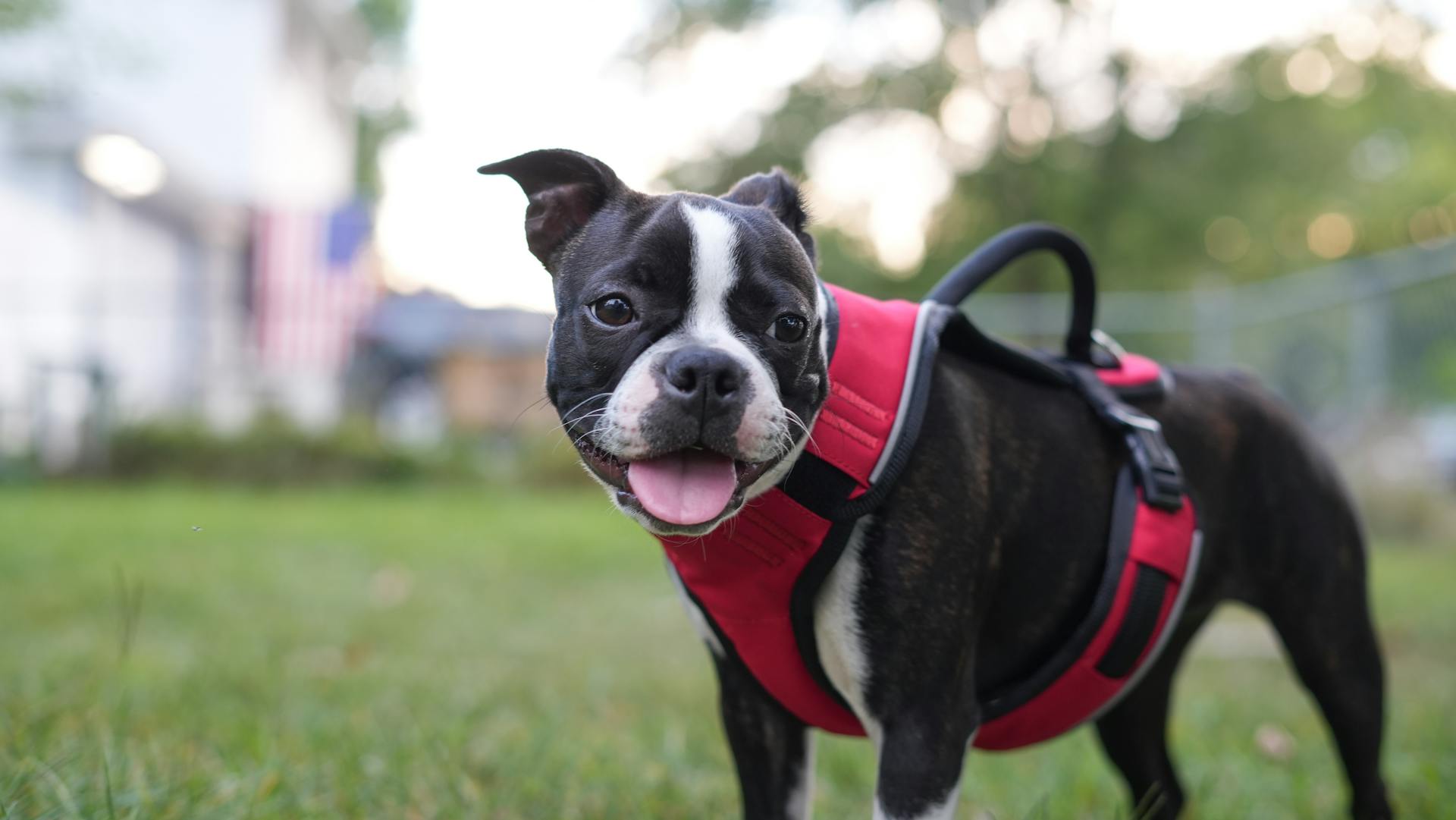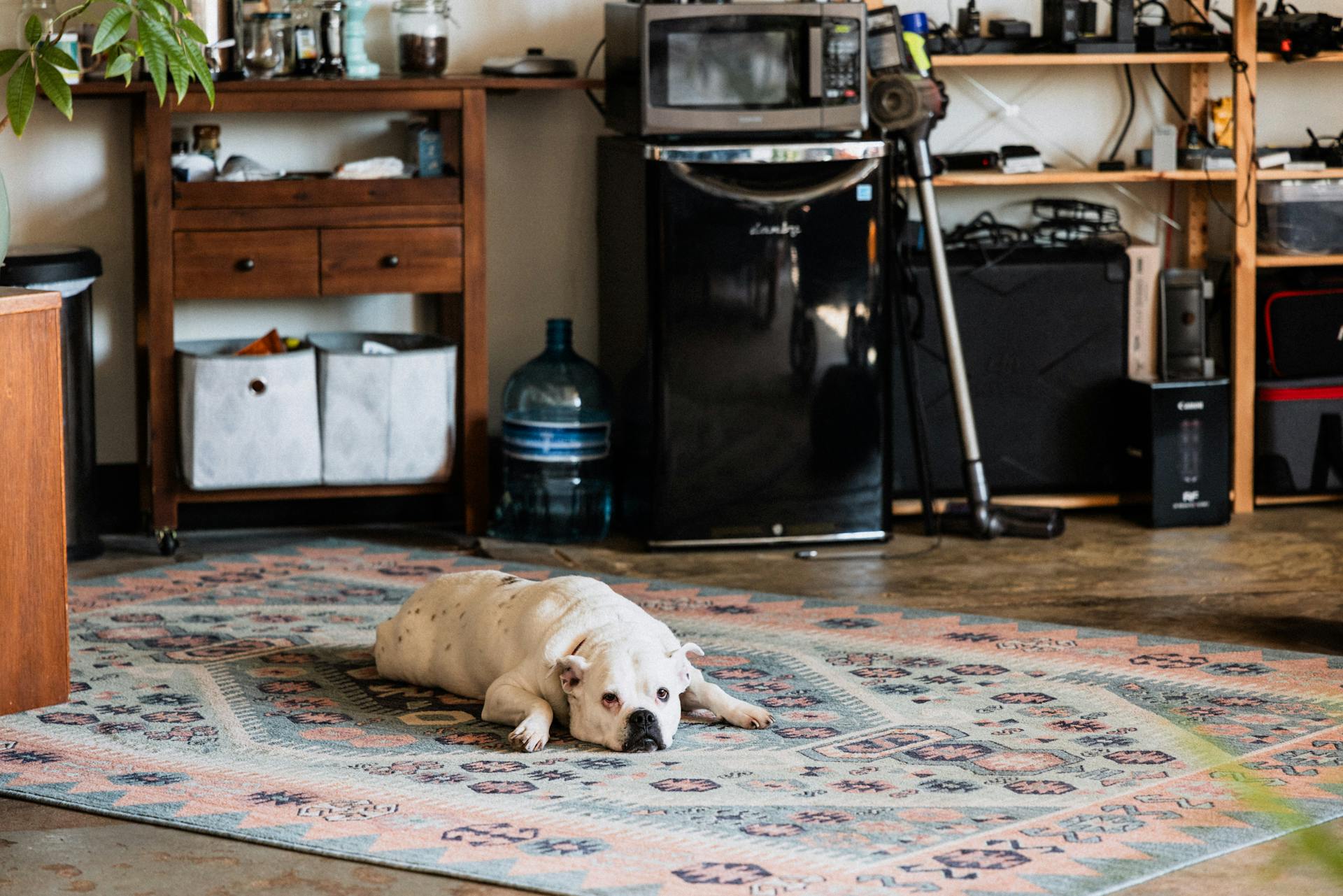
Boston Terrier Cherry Eye can be a painful and distressing condition for both dogs and their owners. Boston Terriers are prone to this condition due to their unique facial structure, with a higher incidence in males.
The condition is characterized by a red, swollen, and sometimes painful mass in the corner of the eye, resembling a cherry. This is caused by a prolapsed gland that can be easily seen and felt.
Left untreated, Cherry Eye can lead to chronic eye infections and even vision loss.
Check this out: Cherry Eye
What Is
Cherry eye is a condition that affects dogs, including Boston Terriers, and is characterized by the prolapse of the gland of the third eyelid.
This gland is a translucent structure that's present inside the lower eyelid of dogs and many other mammals.
The third eyelid acts as an extra protective layer for the eye, particularly useful in fights or when hunting.
It has a specific gland that produces a significant amount of the eye's protective tear film.
Should the gland prolapse or pop out, we call the condition "cherry eye".
Cherry eye may cause some discomfort in dogs.
Here's an interesting read: English Bulldog Cherry Eye Surgery Cost
Causes and Risk Factors
Boston Terrier cherry eye is a common issue that affects many of these adorable dogs. The exact cause of cherry eye is still unknown, but it's suspected that certain breeds, including Boston Terriers, have weaker connective tissues that hold the third eyelid gland in place, making them more prone to cherry eye.
Some breeds are more susceptible to cherry eye due to their genetic makeup. Boston Terriers, along with other breeds like British and French Bulldogs, West Highland White Terriers, and Pugs, are more likely to develop cherry eye.
Cherry eye occurs when the nictitans gland, responsible for producing tears, gets displaced from its usual position. This gland is usually hidden from view, but when it becomes irritated, it can cause discomfort and vision problems for your Boston Terrier.
A ligament normally holds the gland in place, attaching it to the eye socket. However, in certain breeds, this attachment can be weak, causing the gland to pop up and become irritated.
Intriguing read: When Does a Boston Terrier Stop Growing
Here are some breeds that are more prone to cherry eye:
- British and French Bulldogs
- West Highland White Terriers and Lhasa Apsos
- Pugs, Beagles, Boston Terriers, and Great Danes
- Shih Tzus, Bullmastiffs, and Bloodhounds
Younger dogs, especially those under 1 year old, are more likely to develop cherry eye. This is because they may have more allergies, which can cause the gland to become swollen and irritated.
Symptoms and Diagnosis
The symptoms of cherry eye in Boston Terriers can be quite noticeable. The third eyelid gland may pop out of place, causing it to swell and get inflamed and irritated.
One of the most common symptoms is a red, bulging mass in the corner of the eye, which can be painful for your dog. This mass may be accompanied by discharge, redness, and squinting.
As the condition worsens, the affected eye may become inflamed and irritated, leading to excessive tearing, squinting, and pawing at the eye.
See what others are reading: Boston Terrier Mass
Symptoms of
Symptoms of cherry eye in Boston Terriers can be quite noticeable. The third eyelid gland may pop out of place, causing it to swell and become inflamed and irritated.

Cherry eyes are typically not painful, but they can sometimes lead to slight eye discomfort due to inflammation.
A cherry eye can lead to dry eye if the gland begins producing fewer tears over time. Dry eyes can be painful and uncomfortable for your Boston Terrier.
If your Boston's eye appears to be painful, it's essential to get it examined by a veterinarian quickly.
Consider reading: Boston Terrier Dry Skin Home Remedies
Age Range for Development
Cherry eyes are most common in young Boston Terriers, typically developing within the first two years of life.
In my experience, many veterinarians see cherry eyes in dogs of this age range.
It's also worth noting that cherry eyes can occur in Bostons of any age, so it's essential to be aware of the signs and symptoms.
Most commonly, cherry eyes develop within the first two years of a Boston Terrier's life.
This is a crucial age range to monitor for any signs of cherry eyes, such as red or pinkish discoloration in the corner of the eye.
See what others are reading: Toxocara Canis Life Cycle
Treatment and Surgery
Surgical correction is the most common and effective treatment for cherry eye in Boston Terriers.
Surgery is generally considered to be an effective treatment option for cherry eye, with a high rate of success. However, it's essential to note that in some instances the gland may re-prolapse, and multiple surgical interventions may be necessary to fully resolve the condition.
The specific surgical technique used depends on the surgeon's experience and preference. Vets may perform a procedure known as the 'mucosal pocket technique,' where they make a small pocket in the soft tissue at the back of the 3rd eyelid, place the gland into this pocket, and then stitch the pocket shut with dissolvable stitches.
Surgical options have evolved over the years, and what's crucial now is to use a technique that accurately replaces and anchors the third eyelid gently back into its usual location, rather than just excising the eyelid.
Readers also liked: Degenerative Myelopathy Old Dog Back Legs Collapsing
Recovery from surgery is relatively smooth, with most dogs rechecked about 2-4 weeks after surgery. At this time, a Schirmer tear test will be performed to check for dry eye, as it's the most common secondary condition to occur in pets with cherry eye.
To prevent complications, it's essential to keep an Elizabethan collar (e-collar) on your pet while the surgical incisions are healing, as this will prevent the dog from scratching at the incisions, which could potentially cause the surgery to fail.
In chronic or very serious cases, there may be no choice other than to remove the gland, particularly if it no longer functions properly at all. However, this should only be considered as a last resort option and if multiple surgeries have failed to cure the problem.
Check this out: How Big Will My Boston Terrier Get
Management and Recovery
After surgery, your Boston Terrier will likely be rechecked about 2-4 weeks later to ensure everything is healing properly.
Most dogs are at risk of developing dry eye, a common secondary condition to cherry eye, so a Schirmer tear test will be performed to check tear production.
The third eyelid gland produces about 33% of a dog's tears, and when it prolapses, it may become damaged, leading to chronic dry eye.
If tear production is normal after surgery, your vet will likely schedule an annual follow-up Schirmer tear test to monitor tear production.
In some cases, the gland may re-prolapse, requiring multiple surgical interventions, or even referral to a specialist ophthalmic hospital for optimal results.
Between 5 and 20 percent of dogs may experience a re-prolapse and require further surgery.
It's essential to monitor tear production throughout your dog's life to catch any potential issues early on, as chronic dry eye can be a long-term problem.
Readers also liked: Gastric Dilatation Volvulus Surgery
Cost and Considerations
The cost of fixing cherry eyes in Boston Terriers can be a significant concern for many pet owners. The price estimates can range from $300 to $3000, depending on various factors.
Repairing one cherry eye can cost anywhere from $500 to $1500 on average.
If you're considering correcting your Boston Terrier's cherry eyes, it's essential to factor in the potential costs and consider what's best for your furry friend's health and well-being.
Intriguing read: Cherry Eye on English Bulldog
What's in Dogs?
Cherry eye can affect one or both of a dog's eyes, making it a relatively common issue.
Any breed of dog is susceptible to cherry eye, but it tends to be more common in younger dogs.
In fact, some breeds are more prone to cherry eye than others, including Basset Hounds, Beagles, and Bulldogs.
Cherry eye is often caused by a prolapse of the third eyelid gland, which produces about 30% of a dog's tears.
This gland is located in the third eyelid, also known as the nictitating membrane, which moves across the eye diagonally and contains a small T-shaped cartilage.
The remaining 70% of a dog's tears come from the lacrimal gland, located above the upper eyelid.
If this caught your attention, see: Common Dog Diseases and Symptoms
Approximate Cost of Fixing
The approximate cost of fixing cherry eyes in your Boston Terrier can vary widely. Expect to spend between $500 to $1500 for repairing one cherry eye.
The cost can range from $300 to $3000, depending on several factors that will be discussed in more detail later.

One thing to keep in mind is that the average cost of fixing cherry eyes is around $1000, which is roughly the midpoint of the estimated range.
The cost of fixing cherry eyes in Boston Terriers can be significant, but it's often worth it to prevent further complications and ensure your pet's comfort and well-being.
Boston Terrier Specifics
Boston Terriers are one of the breeds more susceptible to cherry eye.
Young Boston Terriers are especially at risk, as symptoms of cherry eye typically arise in dogs less than 2 years of age.
The exact cause of cherry eye in Boston Terriers remains incompletely understood, but research suggests a genetic predisposition may exist.
As a result, Boston Terriers are more likely to experience the third eyelid failing to maintain its usual position within the eye.
The breeds listed below are also prone to cherry eye:
- British and French Bulldogs
- West Highland White Terriers and Lhasa Apsos
- Pugs, Beagles, Great Danes
- Shih Tzus, Bullmastiffs, and Bloodhounds
Terrier Anatomy
Boston Terriers have a unique eye anatomy that's worth exploring. The third eyelid, also known as the nictitating membrane, is a thin layer of tissue that lives in the corner of their eyes.
This third eyelid serves many useful functions to keep the eye working correctly. It has a gland that aids in forming tears, which are essential to keep the eye lubricated and remove foreign substances.
The third eyelid gland can sometimes cause problems, such as cherry eye. The precise cause of cherry eye is unknown, but it's thought to be related to genetics and the way a dog's head is built.
Young Boston Terriers are more prone to cherry eye, often diagnosed before they're a year old. This is likely due to allergies, which can cause the gland to swell and remain swollen.
For another approach, see: Can Allergies Cause Swollen Lymph Nodes in Dogs
Terriers and the Condition
Boston Terriers are prone to a condition called cherry eye, where the gland at the base of the third eyelid becomes displaced and visible as a red, pink, or purple mass. This is usually a result of a genetic predisposition, but the exact cause is still unknown.
Boston Terriers are among the breeds that are more susceptible to cherry eye, along with other small to medium-sized breeds like Pugs, Beagles, and Cavalier King Charles Spaniels. These breeds often have a genetic component to the condition.
Cherry eye can be uncomfortable for your Boston Terrier, and if left untreated, it can lead to worse issues. Surgery is typically the most effective treatment for cherry eye, but it's essential to consult with a veterinarian before trying any home remedies or treatments.
If your Boston Terrier develops cherry eye, it's essential to keep an eye on it and seek veterinary attention if it doesn't resolve on its own within a few weeks. Cherry eye often resolves on its own in younger dogs, but it's always best to consult with a veterinarian for proper diagnosis and treatment.
Here are some breeds that are more susceptible to cherry eye:
- Boston Terriers
- Pugs
- Beagles
- Cavalier King Charles Spaniels
- West Highland White Terriers
- English Bulldogs
- Cocker Spaniels
Keep in mind that cherry eye can occur in any breed, not just those listed above. It's essential to monitor your Boston Terrier's eye health and seek veterinary attention if you notice any unusual redness or swelling.
Frequently Asked Questions
Can cherry eye in dogs heal itself?
Cherry eye in dogs can sometimes correct itself with medication and steroids, but in most cases, surgery is required for a full recovery. However, gentle massage may help reposition the prolapsed gland in some cases.
Sources
- https://www.akc.org/expert-advice/health/cherry-eye-in-dogs/
- https://www.petmd.com/dog/conditions/eyes/c_multi_prolapsed_gland
- https://vethelpdirect.com/vetblog/2021/02/09/how-to-treat-cherry-eye-in-dogs/
- https://cooperpetcare.com/cherry-eye-dogs/
- https://www.bostonterriersociety.com/cherry-eyes-in-boston-terriers/
Featured Images: pexels.com

